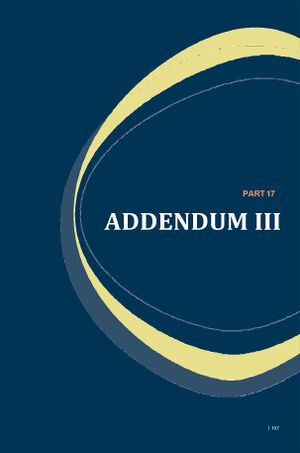Addendum III
From Wiki

Example of a List of Requirements for a Digital Archiving System for a CSO archive
A Digital Archiving System needs to meet the following requirements to be selected. To perform to a high standard, it must include the following archival functions:
- Appraisal
* Description
* Arrangement
* Capturing and storing metadata
* Ingest
* Retention
* Backup
* Long-term preservation
* Maintaining integrity and credibility of data
* Recording chain of custody
* Safeguarding data
* Providing access
* Managing and administering data
* Migrating data to other formats, software and storage media
In addition to high quality of performance the Digital Archiving System is required to have integrated standards for these archival functions (i.e., the OAIS Reference Model and the standards related to it). In addition:
- The software and hardware components of the Digital Archiving System need to be compatible with each other, as well as with other technologies and information systems the organization already uses (e.g., databases and servers it needs to interact with).
A Digital Archiving System is required to enable storage and management of all types and formats of data contained in the archive.
- The requirement is to minimize the costs related to purchase and maintenance of the Digital Archiving System.
- In terms of human resources, the requirement is that the Digital Archiving System can be implemented with no or minimal increase to the organization’s staff. The Digital Archiving System should also provide opportunities for training of staff members working on the digital archive.
- The Digital Archiving System should provide strong user support and the possibility for quick access to expert assistance and troubleshooting.
- The longevity requirement for the Digital Archiving System is to provide for as long-term a solution as possible and feasible. The requirement is also to minimize any major maintenance, updates, or upgrades that are needed over a product’s life cycle. A product that has a proven track record and a wide user community will be considered more likely to provide a long-term solution than will a novel product.
- Both software and hardware components need to be well-tested and have good to excellent user [NK|FP1] feedback, with proven reliable and consistent performance.
- The Digital Archiving System will be required to allow for streamlined, safe, and accurate migration and transfer of data to future file format, software, and storage media solutions.
- To facilitate efficient and streamlined use of the archival material, software that provides for an ergonomic and user-friendly interface is needed.
- The storage media must provide sufficient capacity for both current and future expected additions of material to the digital archive. This includes assessment of whether the storage media capacity can be easily and feasibly increased to provide for future needs.
- The selected Digital Archiving System must provide for adequate, regular, and sufficient backup of data. This includes storing the data in two or more separate storage units at separate geographical locations and, if possible, on different storage media.
- A requirement for the Digital Archiving System is that it provide for stable and safe storage (i.e., without changes or deterioration of records and ensuring that the data cannot be lost). The storage media should provide for a method of detecting errors in writing/reading of data onto storage, as well as for data recovery in case of failure.
- The storage media must be resilient to physical damage and other factors that can damage the records.
- Financial, technical, and human resources needed for obtaining, implementing, and maintaining the Digital Archiving System need to be feasible and sustainable for the organization in the long term.